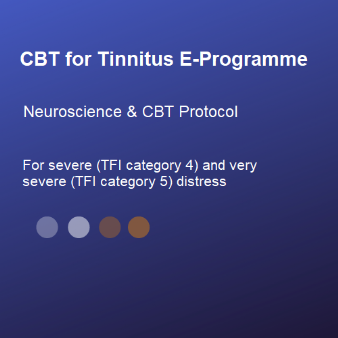Guiding Principle
Published by Debbie Featherstone in It's more than tinnitus · Saturday 18 Jun 2022
There is one specific and important guiding principle to keep in mind when using Cognitive Behaviour Therapy for tinnitus:
Cognitive Behaviour Therapy is a treatment for the DISTRESS that tinnitus causes
Let me explain…. We can hear any noise and have little to no conscious awareness of it. We do it all the time: for example, when in a shopping mall, on a busy street, in a car, on the bus or train. Were we to have the full-on experience of all the sounds 100% of the time in these environments, we'd be overloaded and very much overwhelmed by the cacophony of sounds. Even at home – inside or out: we can read a book or magazine while the tv is wittering on in the corner, or not notice the birds twittering when we are in the garden. There is a simple explanation of this known as Ramsdell's model of hearing that is discussed in Stage 3 of the CBT for Tinnitus E-Programme.
Some of us develop a ‘sensitivity’ to noise – sometimes to any noises, sometimes to particular types of noise. Most of us cringe at the scraping of nails down a blackboard, for example. And when we become aware we are in a situation where we might expect a cringe-worthy noise to happen, our brain goes in to a vigilance state, whereby it anticipates that an offending noise may happen at any time. In a vigilance state, the brain – and indeed the body – go in to threat-mode. We don’t consciously decide to do this – it’s our subconscious that takes over and makes it happen.
This is where we are when we have tinnitus distress.
If we have "decided" we don’t like the tinnitus, don’t want it, have negative feelings about it, predict good or bad days depending on “how loud” tinnitus is, we have unwittingly given the brain a reason for the subconscious to take over. These feelings are both sensations (feelings we can feel in our body like tensing up) and emotions (emotions like fear, anger, sadness, just to give three common examples). These feelings and emotions become ‘wired’ in to subconscious areas of the brain, and thus become a blueprint for how and what we think, how we behave and what we do. Internally (subconsciously for the most part), we create narratives (stories) around it all that emphasise, support, grow and embed those negative feelings and emotions. We have given a ‘threat-meaning’ to the tinnitus; we believe our narratives and thus become someone with ‘‘tinnitus distress’’, rather than someone who “has tinnitus”. The way we tell a story has MUCH MORE POWER than the story itself.
Take the distress away, and we notice the tinnitus less; and even when we do notice it, we don’t care so there’s no reason to remember to think about it.
Cognitive Behaviour Therapy is re-training how and what we think, and how and what we do. It takes the distress away through enabling the blueprint we created earlier to change to a different blueprint – one where we have learned not to care whether tinnitus is there or not. We have removed the made-up threat we unwittingly created around having tinnitus.
NOTE: While it is true that a high proportion of people experience a lowering in volume (loudness perception) of their tinnitus by the time they have reached stages 4-6 (of the 12 stages) of the CBT for Tinnitus E-Programme process, this is mostly due to the cumulative impact of 'little and often, regular and consistent' use of short breathing exercises (2-3 minutes each time) and relaxation, so the early change in loudness perception is more a result of behaviour changes rather than cognition changes. CBT combines Behaviour and Cognitive therapy.
Debbie Featherstone MSc
Hearing Therapist & Psychotherapist
18th June 2022
0
reviews



